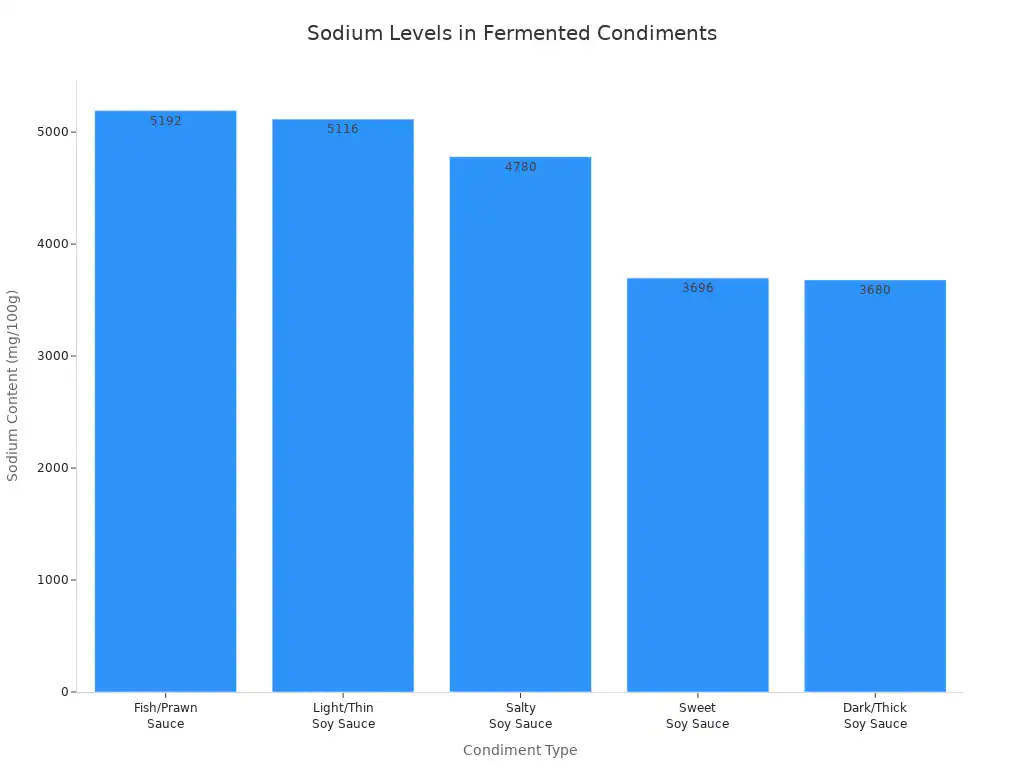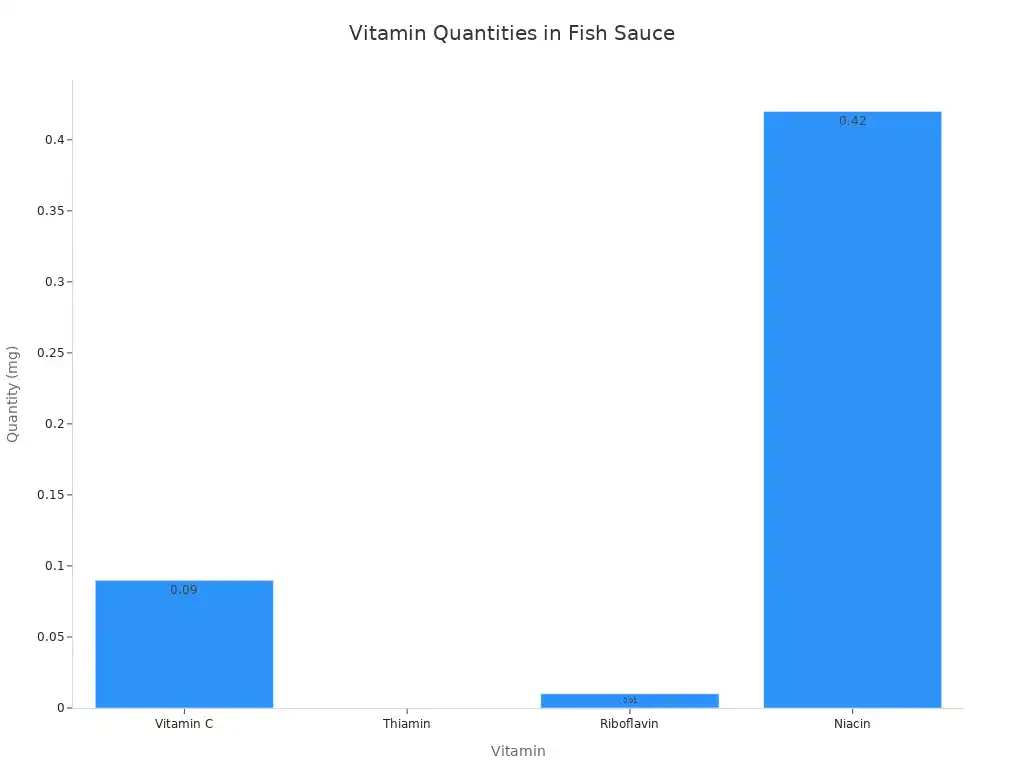
Fish sauce stands as a cornerstone condiment in Southeast Asian cuisine. It offers a unique umami flavor. This umami-rich condiment enhances many dishes. The global fish sauce market reached USD 18.47 billion in 2024. This shows its significant presence worldwide. However, fish sauce nutrition presents a key concern: its high sodium content. The high sodium levels in fish sauce warrant attention. Understanding the components of this versatile fish sauce is important for a balanced diet. Its distinct flavor adds depth to various culinary creations.
Key Takeaways
Fish sauce is a popular condiment. It adds a unique savory taste to many dishes. Makers ferment fish and salt to create it.
Fish sauce has a lot of sodium. One serving can be more than half of your daily salt limit. Too much sodium can cause health problems.
Use fish sauce in small amounts. You can also try lower-sodium options. This helps you enjoy its flavor without too much salt.
Fish sauce adds a deep, savory flavor called umami. It makes many foods taste better. It is used in both old and new recipes.
Understanding Fish Sauce

Fish sauce is a liquid condiment. It comes from fish or krill coated in salt. People ferment it for up to two years. This spicy sauce is made from the fermented liquid of salt-cured fish, especially anchovies. It is popular as a flavoring or condiment in East and Southeast Asian cuisine. This funky, flavor-enhancing fermented condiment is integral to Southeast Asian cooking. It also has ancient Roman origins. Fish sauce is a popular condiment. It is prepared by the autolysis of fish using in situ proteolytic enzymes. Production can be accelerated by exogenous proteases.
Fermentation Process
The creation of fish sauce involves a detailed fermentation process. Makers mix fish and salt. A common ratio is three parts fish to one part salt. This mixture ferments in large wooden barrels. The fermentation period for traditional fish sauce often lasts 18 to 24 months. This extended time allows for natural fermentation. It also helps beneficial bacteria develop. This process contributes to the optimal protein content and unique flavor of the fish sauce. Achieving a specific flavor profile for fermented sauce can require a fermentation period of approximately six months to one year. Some methods, like a two-step fermentation, can yield good flavor in shorter durations, such as 4–7 days.
Basic Components
The primary ingredients for fish sauce are simple. They include fresh fish and sea salt. Anchovies are typically the main fish used. However, makers also use mackerel and other small fish. Water and sometimes sugar are also common additions. The salt plays a crucial role. It helps preserve the fish and drives the fermentation. This combination of ingredients and the long fermentation process gives fish sauce its distinctive umami flavor.
Fish Sauce Nutrition: Sodium Focus
Understanding the nutritional facts of fish sauce helps consumers make informed dietary choices. A typical serving of fish sauce is small, but its impact on daily sodium intake is significant.
Sodium Levels
A standard serving of fish sauce is usually around 18g or 19g. This small amount contains approximately 10 calories. While fish sauce is a moderate-calorie condiment, people typically use only a few milliliters at a time. For example, 100 grams of fish sauce contains about 35 kcal, and one tablespoon (18g) provides around 6 kcal. Another common measurement shows 100g contains 240 kcal, with a tablespoon (≈15g) having 36 kcal. A 16g serving of fish sauce contains 5.6 calories.
The primary concern regarding fish sauce nutrition is its high sodium content. A single serving often contains between 1480mg and 1560mg of sodium. This amount can represent more than half of the recommended daily limit for a healthy adult. Each serving generally provides 0g fat, 1g to 2g protein, and 1g carbohydrates. Some brands list 1g of sugar per 19g serving. The substantial amount of salt in fish sauce contributes to its strong flavor and preservative qualities.
Sodium Comparison
Fish sauce stands out among fermented condiments for its sodium levels. It often contains more salt than many other popular sauces.
Condiment Type | Sodium Content (mg/100g) |
|---|---|
Fish/Prawn Sauce | 5192 ± 3228 |
Light/Thin Soy Sauce | 5116 ± 2084 |
Salty Soy Sauce | 4780 ± 988 |
Sweet Soy Sauce | 3696 ± 2000 |
Dark/Thick Soy Sauce | 3680 ± 2180 |
This table clearly shows that fish/prawn sauce, which includes fish sauce, has the highest average sodium content. Studies in Malaysia report that fish sauce contains a very high percentage of salt, ranging from 20.72% ± 0.17% to 25.10% ± 0.10% (weight per volume). This high concentration makes it a potent flavoring agent but also a significant source of sodium in the diet.

The chart visually reinforces the high sodium levels in fish sauce compared to other fermented condiments. This highlights the need for moderation when incorporating fish sauce into meals.
Trace Nutrients
Despite its high sodium content, fish sauce does offer some nutritional value beyond flavor. It contains various trace elements and some vitamins, though often in small quantities.
Some trace minerals found in fish sauce include:
Mercury (Hg)
Cadmium (Cd)
Lead (Pb)
These elements are typically present in very small amounts. If producers use Himalayan pink salt in its production, it can contribute 84 natural minerals to the fish sauce. Additionally, fish sauce contains iodine when producers use iodated salt.
Regarding vitamins, fish sauce contains several, but their quantities are often negligible. The nutrition profile shows:
Vitamin | Quantity (mg) |
|---|---|
Vitamin C | 0.09 |
Thiamin | 0 |
Riboflavin | 0.01 |
Niacin | 0.42 |

While many vitamins are listed for fish sauce, including Vitamin B6, Niacin, Selenium, and Folate, their quantities are often unavailable or negligible. For instance, a 5ml portion might contain about 8.75mg of magnesium. Therefore, people do not typically consume fish sauce for its nutritional values of vitamins and minerals, but rather for its unique flavor.
Sodium Health Effects
High Sodium Risks
High sodium intake has significant health effects. Higher salt intake connects to increased blood pressure. It also links to elevated triglyceride levels. Approximately 1.89 million deaths annually are associated with too much sodium. These deaths are mainly due to high blood pressure and heart disease risk. High sodium consumption is a major risk factor for non-communicable diseases worldwide. Fish sauce is a primary contributor to high sodium intake in countries like Thailand. A single tablespoon of fish sauce can contain up to 1,500 mg of sodium. This is more than half of the daily recommended limit for a healthy adult (2,300 mg). High sodium intake from fish sauce can worsen conditions like high blood pressure, heart disease, and kidney failure. This is especially true for people on a sodium restriction. High dietary sodium can harm blood vessels, the heart, kidneys, and brain. It can impair blood vessel function and make arteries stiffer. It also links to thicker heart walls and reduced kidney function. High sodium intake shows a positive link with blood pressure. This then raises the risk of cardiovascular diseases (CVD). Excess salt consumption is the main dietary risk factor for CVD globally.
Metric | 1990 Value | 2019 Value | Change (1990-2019) |
|---|---|---|---|
Deaths from HSI-related CVD | N/A | 1.72 million | +41.08% |
DALYs from HSI-related CVD | N/A | 40.54 million | +33.06% |
Moderate Sodium Benefits
Sodium is vital for the body. It helps the body keep fluids in a normal balance. Sodium also plays a key role in normal nerve and muscle function. The total amount of salt in the body affects blood volume and fluid around cells. These benefits come from moderate intake, not from too much.
Sodium Reduction Strategies
People can use strategies to reduce sodium when cooking with fish sauce. Moderation is crucial. Use small amounts of fish sauce. Balance it with low-sodium ingredients. Monitor total daily sodium intake. This helps incorporate fish sauce healthily. For a low-sodium diet, consider alternatives. Coconut aminos are a lower-sodium option. One tablespoon of coconut aminos has 198 milligrams of sodium. This is much less than fish sauce. Coconut aminos are also vegan and gluten-free. Worcestershire sauce is another alternative. It contains 65 mg of sodium per teaspoon. It offers a similar umami flavor. People can also make a low-sodium fish sauce recipe. This recipe uses ingredients like shallots, white vinegar, white wine, and no-salt seasoning. It also includes clam juice and fish stock. This helps people on a sodium restriction enjoy similar flavors with less salt.
Tip: To make a low-sodium fish sauce, sauté shallots, add white vinegar and wine, then stir in no-salt seasoning and lemon juice. Reduce the mixture, then add clam juice and fish stock. Simmer to meld flavors.
Culinary Uses and Flavor

Fish sauce is a powerful ingredient in many kitchens. It offers a unique taste experience. This umami-rich condiment transforms dishes. It adds depth and complexity.
Umami Enhancement
Fish sauce is a crucial ingredient in many cuisines. It acts as a ‘secret ingredient’ that adds depth and complexity to dishes. Makers ferment fish, typically anchovies, with sea salt. This process creates a liquid rich in umami. This condiment is vital for balancing salty, sweet, sour, and spicy notes. It serves as the ‘backbone’ of flavor harmony. Its ability to elevate a dish without overpowering other ingredients comes from its umami. Umami enhances flavor overall. The taste of fish sauce is subtle. It focuses on richness and balance rather than a strong ‘fish’ flavor.
Fish sauce, a fermented product, is rich in glutamate. Glutamate is a primary contributor to the umami taste. Foods that show an umami taste, including fish sauce, contain high levels of L-glutamate. They also contain inosine monophosphate (IMP) and guanosine monophosphate (GMP). These compounds create the deep, savory notes.
Fish sauce interacts with other ingredients to amplify their natural flavors. It adds savory notes. It balances other tastes like sweetness, saltiness, acidity, and spice.
Burgers: Mixing fish sauce into burger meat enhances the sensation of meatiness. It adds a powerful umami kick, making them extra savory.
Pizza (with Tomatoes): Fish sauce pairs well with tomatoes. It amplifies their natural sweetness and acidity. It also adds deep savory notes. It can heighten the flavors of umami-rich toppings like cured meats, mushrooms, and certain cheeses.
Roasted Vegetables: The umami in fish sauce brings out the earthy flavors of mild vegetables like potatoes and cauliflower. It can temper sweetness in high-sugar vegetables like carrots and beets. It makes Brussels sprouts taste nuttier. It benefits roasted broccoli with a briny hit.
Thai Curries: Fish sauce adds salty, umami notes. It helps balance and tie together the spicy, sour, sweet, and rich flavors typically found in Thai curries.
Soups (e.g., Tom Yum Goong, Pho, Laksa): Fish sauce adds savory undertones. People can use it in place of salt for a more complex salinity. It contributes to the rich flavor profile of Southeast Asian soups.
Traditional Applications
Fish sauce has a long history. Ancient Greeks produced the earliest recorded fish sauce, gàros. They made it along the Black Sea coast as early as the 7th century BCE. They used abundant fishery resources. Carthaginians also produced and traded fish sauce early on. They made it along the coast of the Lake of Tunis. Evidence includes a 5th-century BCE Punic shipwreck off Ibiza. It carried fish sauce in amphorae. Roman fish sauce, known as garum, was very popular. Its production and trade were widespread. Literary references suggest it was a common ingredient in the ancient Mediterranean.
Historians debate the origins of Asian fish sauce. Some suggest it came from the West via the Silk Road. Others, like Mark Kurlansky, theorize independent development. Kurlansky thinks Asian fish sauce may have started in Vietnam. It possibly had influence from ancient Chinese fermented fish with beans. Laura Kelley, a food historian, suggests garum was the precursor. It traveled east along trade routes. It evolved into nuoc mam and nam pla. Modern fish sauce is a staple in Southeast Asia. Vietnamese Phu Quoc fish sauce has received EU Protected Designation of Origin certification.
Modern Adaptations
Chefs now use fish sauce in many modern dishes. It goes beyond traditional Asian cuisine.
It acts as a flavor enhancer in dishes like beans.
People use it as a substitute for anchovies in Caesar salad and other dressings.
It appears in meat marinades.
Chefs splash it on racks of ribs before applying a rub.
It goes into stews.
It enhances pasta sauces.
People use it as a substitute for Worcestershire sauce in dishes like burgers, chili con carne, and cocktails.
It is an ingredient in raw kale salad dressing.
Innovative recipes incorporate fish sauce into Western dishes.
Caesar dressing
Bolognese
Beans on toast
Marinara
Pan-Seared Fish Sauce Pork Chops
Garlicky Fish Sauce–Spiked Tomato Sauce with Bucatini and Ricotta
Shortbread cookies with a calamansi and patis glaze
Spicy caramels
Flavor Balancing Tips
Fish sauce has a strong flavor. People need effective techniques to balance it in recipes.
Use it in moderation. A small amount, like a teaspoon or two, often suffices to enhance flavor without overpowering the dish.
Balance it with other ingredients. Combine it with lime juice, garlic, chili, and sugar. This works especially well in dressings, marinades, and dipping sauces, such as Vietnamese nuoc cham.
Use it as a marinade base. Mix it with honey, ginger, and lime juice for a sweet, tangy, and savory profile.
Substitute it for other ingredients. It can replace anchovies or Worcestershire sauce in Western dishes. Examples include tomato sauce, beef stew, or Bloody Marys.
Heat or mix it into sauces. The strong aroma and sharp edge of fish sauce mellow when heated or thoroughly mixed with other ingredients.
Start small and taste as you go. Gradually add fish sauce to achieve the desired flavor balance.
Incorporate it into various dishes. Add it to scrambled eggs, chili, mayonnaise, soups, roasted vegetables, meatloaf, burger mixes, and vinaigrettes.
To add depth without overpowering a dish, combine two parts fish sauce with three parts water for dipping sauces. Add chiles and minced garlic. Use it as a foundational element in Viet-style quick soups (canh) with gently sautéed onion and salt. Add it to oyster sauce to enhance its sweet, briny nature. Incorporate it into marinades, such as for shaking beef, alongside oyster sauce and soy sauce. It plays a supporting role there to add ‘gravitas’.
Combine fish sauce with salt to impart different kinds of savoriness. This prevents overwhelming funk. Add sugar or maple syrup if the fish sauce lacks a built-in sweetener or umami booster. Add fish sauce earlier in the cooking process. Adding it at the end can result in a too-pronounced pungency. Balance the flavors by adding a little sugar to the dish when using fish sauce. For example, add 1 tablespoon of sugar to beef stew broth. Start with small amounts, such as 1 teaspoon. Taste as you go to adjust to personal preference.
Selection and Storage
Choosing the right fish sauce and storing it properly ensures the best culinary results. Understanding key indicators helps consumers make informed decisions.
Quality Indicators
Consumers often wonder how to choose fish sauce. Several factors indicate a high-quality fish sauce. Vietnamese fish sauce is often considered refined. Labels on these products often show the origin, degrees, and fish types. The “degrees” (°N) represent protein content. A higher value means more protein and umami, which often leads to a higher price. Degrees range from 20°N to 60°N. Lower degrees are good for cooking. Higher degrees are better for dipping sauces.
A superior fish sauce appears clear. It has a deep amber color. The aroma should be rich and complex, not overly pungent or harsh. Its flavor offers a strong umami taste with balanced saltiness. It enhances dishes without overpowering them. Look for fewer ingredients on the label. This usually means higher quality. Also, check for a nitrogen content number like –°N, –N, –°, –do dam, or –dam. Higher N-numbers show better quality. While ‘Phú Quốc’ can suggest a good origin, it does not always guarantee quality due to labeling practices. A higher price often indicates better quality. Sauces with higher N-numbers cost more. Glass bottles usually hold better quality than cheaper plastic ones.
Varieties and Brands
Many varieties of fish sauce exist. Different regions produce their own versions. These variations come from different fish types and fermentation methods. Consumers can find many brands on the market. Each brand offers a slightly different flavor profile. Experimenting with different brands helps people find their favorites.
Proper Storage
Store fish sauce in a cool, dark place. A pantry or cupboard works well. Refrigeration is not always necessary. However, it can help maintain the flavor and color over a longer period. Always keep the bottle tightly sealed after each use. This prevents air exposure. Air can change the flavor and color of the fish sauce. Properly stored, an opened bottle of fish sauce can last for several months, or even up to a year.
Fish sauce nutrition reveals its high sodium content. Therefore, moderation is essential. This versatile fish sauce enhances flavor in many dishes. It adds a unique taste to various cuisines. When used mindfully, fish sauce can be a delicious and beneficial addition to a balanced diet. Readers should experiment with fish sauce, understanding its nutritional impact and sodium levels. Its distinct flavor makes it a valuable ingredient.
FAQ
What is fish sauce?
Fish sauce is a liquid condiment. It comes from fish or krill. Makers ferment it with salt for up to two years. It adds a unique umami flavor to many dishes. It is a staple in Southeast Asian cuisine.
What makes fish sauce taste umami?
Fish sauce contains high levels of glutamate. Glutamate is a compound. It creates the savory umami taste. The fermentation process develops this flavor. It enhances the overall taste of food.
What is the main nutritional concern with fish sauce?
The primary nutritional concern is its high sodium content. A single serving can contain over half of an adult’s daily recommended sodium limit. People should use it in moderation.
What are some ways to reduce sodium when using fish sauce?
Use small amounts of fish sauce. Balance it with low-sodium ingredients. Consider alternatives like coconut aminos or homemade low-sodium versions. Always monitor your total daily sodium intake.



